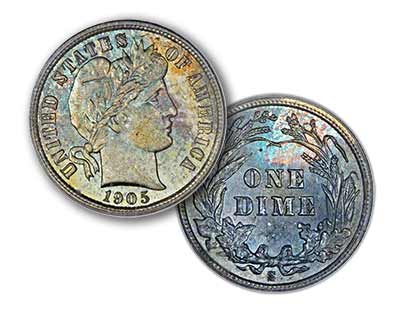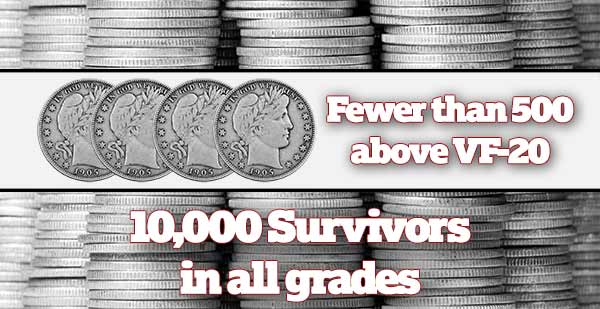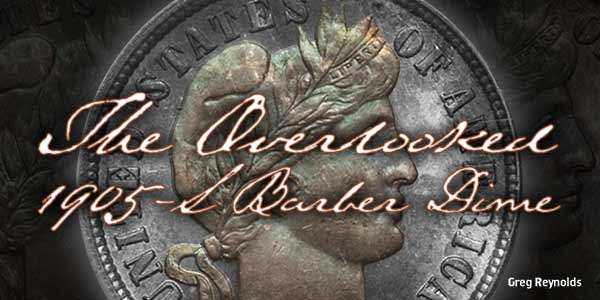Coin Rarities & Related Topics: News and Analysis regarding scarce coins, markets, and coin collecting #365
A Weekly CoinWeek Column by Greg Reynolds …..
On January, 4, 2017, in the upcoming FUN auction, Heritage will offer a PCGS-graded MS-66 1905-S dime that has not received much attention and could be an excellent value for a collector-buyer. Though not one of the most expensive or one of the rarest items in this auction, it is exceptionally attractive and is a ‘better date’ in a popular series, in addition to being fairly graded and among the finest known. This coin is one of the eight highest-graded 1905-S dimes to be approved by CAC.
As neither a key date nor a common date, the 1905-S is not often mentioned in the context of Barber dimes. The 1905-S, however, is a ‘better date’; it is much scarcer than the ‘common dates’ in the series.
Most 1905-S dimes are not nearly as expensive as a certified MS-66 coin. In Good-04 grade, a 1905-S would probably retail for $5 to $8 USD. In contrast, Good-04 grade common date specimens probably tend to retail at small-to-medium size coin shows for around $3, if that much.
An Extremely Fine grade 1905-S dime might retail for $50. A ‘common date’ Barber dime in Extremely Fine grade–such as a 1910, a 1908-D or a 1916-S–would probably retail for half as much, more or less.
Since I was a kid, Barber dimes have been among the most popular series of classic U.S. coins. Although some time and effort may be required, kids and adult newcomers now can find Good grade Barber dimes for less than $3 each, and probably even a gradable 1905-S for less than $6.
Gardner Collection 1905-S Dimes
The 1905-S now being offered is one of two 1905-S dimes that were in the Gene Gardner Collection. The other was NGC-graded “MS-67.” That piece realized $4,553.13 in October 2014. Earlier, that 1905-S brought $6,037.50 in the June 2005 Long Beach auction.
The auction record for a 1905-S dime was set when Sotheby’s auctioned the John Moores Collection in November 1999 in New York. A PCGS-graded MS-67 1905-S then went for $8,525!

In December 2014, the Simpson 1905-S, which is PCGS-graded as MS-67, brought 6,756.25. Are the Moores and the Simpson 1905-S dimes the same coin? I do not have immediate access to my Moores catalogue.
In July 2016, a PCGS-graded “MS-66+” 1905-S realized $2,232.50. Although that piece was CAC-approved, it is important to keep in mind that experts at CAC ignore the plus aspects of plus grades assigned by graders at PCGS or NGC. In another words, if experts at CAC place the grade of a submitted coin in the middle of the 66 range, it will receive a sticker, regardless of whether it has been PCGS- or NGC-graded as “66” or “66+”. A coin that ‘stickers’ at 66 will also ‘sticker’ if it is upgraded to “66+”, unchanged and resubmitted to CAC, according to CAC policy.
I did not see that PCGS-graded “MS-66+” 1905-S. I am not commenting as to whether it merits a ‘+’ grade. I would be surprised, though, if it were as attractive as the PCGS-graded MS-66 Gardner piece that is being offered again at the FUN show. PCGS graded this 1905-S during the 1990s and is in a holder with an old green label (‘insert’).
This Gardner 1905-S is more than attractive. The blue, green, russet and orange tones have blended well together. I really enjoyed viewing this coin. It has a level of eye appeal that most experts would associate with an MS-67 grade. A few small imperfections on Miss Liberty’s face and neck probably prevented this coin from grading MS-67.
As a certified “MS-67” 1905-S would likely sell for between $4,000 and $7,500, this Gardner pedigreed MS-66 1905-S coin might be an excellent value, even though it isn’t flawless. In May 2015 at the Gardner III sale, this same coin brought $1,527.50. It was worth far more in March 1990, more than 25 years ago!
Of course, it is plausible that this 1905-S dime could bring more than that on January 4, 2017. In May 2009, a PCGS-graded MS-66 1905-S, with a CAC sticker, was auctioned for $3,220.
In recent years, two PCGS-graded MS-66 1905-S dimes without CAC stickers have each brought $1,400. One sold in October 2014 and the Lily Nicole 1905-S was auctioned in April 2015.
There are not more than a dozen 1905-S dimes that most relevant experts would grade as MS-66 or higher. If, as I suggest, just around 375 different 1905-S dimes have been PCGS- or NGC-certified in any grade, an exceptionally attractive ‘MS-66’ 1905-S for less than $2,000 is a good value for a collector who enjoys the aesthetics of gem quality, classic U.S. silver coins.
Condition Rarity and Total Scarcity
In all grades, PCGS and NGC have certified fewer than 500 1905-S dimes. Further, the reported totals include many resubmissions of some of the same coins. A certified “MS-65” 1905-S tends to be worth twice as much as a similarly certified “MS-64” 1905-S dime. On average, a certified MS-66 1905-S dime is worth more than twice as much as an extremely similar, certified MS-65 1905-S.
In the context of classic U.S. coins, gem Barber dimes are not extremely valuable in absolute terms. Curiously, though, gem quality Barber dimes were much more valuable in the late 1980s and the late ’90s than they are in the present. During those time periods, there was a very strong motive to attempt to ‘upgrade’ them.

It may be relevant that PCGS reports grading 25 1905-S dimes as “MS-65”, and NGC, 13 – for a total of 38. CAC, however, has approved just two at the MS-65 level, for a total of 10 from MS-65 to -67. Within this combined total of 38 as grading “MS-65”, there are multiple counts of some of the same coins and there are counts of 1905-S dimes that were earlier certified as grading ‘MS-64’.
As uncirculated Barber dimes often have fuzzy highpoints on the obverse, uncirculated coins are often undergraded in the AU range and some AU grade coins are overgraded as ‘mint state.’ Barber dimes that are certified as AU-58 have (probably) been frequently re-submitted in search of ‘mint state’ grades. The 38 1905-S dimes that have been PCGS-graded as AU-58, and the 28 dimes that have been so graded by NGC, probably amount to fewer than 30 different coins.
Interesting questions relate to those 1905-S dimes that have never been submitted to PCGS or NGC. Generally, most surviving Barber coins grade below VF-20.
There are probably more than 10,000 1905-S dimes around, though probably less than 500 of these merit grades above VF-20. Even if there are 800 that grade above Fine-15, this is a noteworthy non-large number, as thousands of people collect Barber dimes ‘by date’.
Top Sets of Barber Dimes
The finest extant set is owned by Stewart Blay, though Stewart’s set has not changed much (if at all) in years. At least one other collector is avidly pursuing gem quality Barber dimes. In the near past, though, there was more competition for these.
Gene Gardner’s Barber dimes were auctioned in 2014 and 2015; the Simpson set of business strike Barber dimes was auctioned in December 2014; and the Lily Nicole set was auctioned in April 2015. Therefore, three leading sets of business strike Barber dimes were auctioned during a period of two years, starting less than three years ago.
John Hugon’s epic set was sold in January 2005, and Dr. Duckor’s set was auctioned in January 2006. Mark Miller’s set went ‘on the block’ a few years later.
Although he may never have obtained a 1905-S, a collector with the code name, “Joseph Thomas” was in the process of building a gem quality set of Barber dimes. Many highly certified, business strike Barber dimes were included in the primary auction of his collection in April 2009.
In 2007, I analyzed the sale of an 1893-S dime that was auctioned for $63,250, an astonishing result. It was PCGS-graded as MS-67.
In April 2009, when coin markets were bottoming out, that same “Joseph Thomas” 1893-S brought $51,750. Although less than the $63,250 result in 2007, the price of $51,750 was an amazing auction result in April 2009, in an event where many coins were selling for fractions of their respective values in 2006 or 2007. After trending steeply downward in late 2008 and early 2009, markets for rare U.S. coins did not largely recover until some point in 2010.
Relative Prices
It will be interesting to research market levels for gem Barber dimes in 2017. Will prices realized for Barber dimes in the Simpson, Lily Nicole and Gene Gardner offerings over the past three years be thought of as low in the future? A prediction is neither expressed nor implied here.
To understand market values for coins in individual series or particular grade ranges, there is a need to shift focus from the total value of a large number of classic U.S. coins and instead analyze relative prices. In the study of coin markets, relative prices are just as important as aggregate values.
The relative demand for classic U.S. coins changes over time. Coins that are very popular in one bull market may be relatively less popular in another. When prices for most coins fall, prices for some coins will rise or not fall nearly as much.
If all the total market value of all classic U.S. coins changes by X%, whatever X turns out to be, the relative value of each coin or each category of coins will not change by exactly X%. If X is positive, some coins may rise by twice that (2X%) while other coins rise by half as much (0.5%X) as the overall average or even fall in value.
During the late 1980s, prices for many circulated coins fell while markets for corresponding gem quality coins boomed. During the collecting boom from 1997 or so until 2007 or thereabouts, prices for circulated and uncirculated classic U.S. coins rose substantially in value, particularly from 2003 to 2007.
Many circulated rare gold coins were fading, while being largely ignored, during the 1990s. These same coins were subject to rising, intense demand from 2004 to the middle of 2008.
Prices for many certified MS-66 to -68, late 19th century and early (pre-1934) 20th-century silver and nickel coins are now far from respective peaks reached during the period from late 2006 to the middle of 2008. Current prices for these also tend to be lower from levels reached during the first part of 2015. Are prices for Barber dimes more likely to bounce back than prices for some of the other coins in this category?
An attractive set of gem quality, ‘mint state’ Barber dimes is a practical objective for many of the people who buy high-quality, classic U.S. coins. No business strike Barber dimes are rare, and Barber coins tend to naturally tone well in contrast to most other series of classic U.S. silver coins. Superb Barber coins tend to be exceptionally attractive and distinctive, while Mercury dimes and Standing Liberty quarters have not naturally toned as well over the years, on average.
Appearances notwithstanding, it is important to not rely upon generalizations. Of course, there exist wonderful Mercury dimes and Standing Liberty quarters, including one quarter that I focused upon about two weeks ago.
Understanding market levels involves perceptions of current collector demand. To attain insights regarding changes in prices, it is essential to think about the changes in preferences of collectors and the history of coin collecting. An understanding of history is required to meaningfully analyze phenomena in the present, and to form rational expectations about the future.
© 2017 Greg Reynolds





